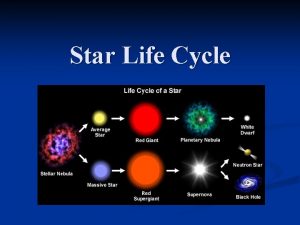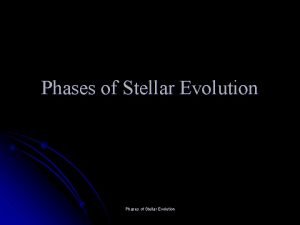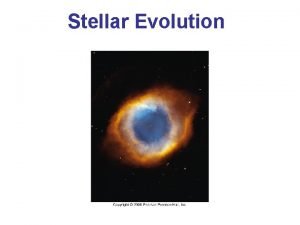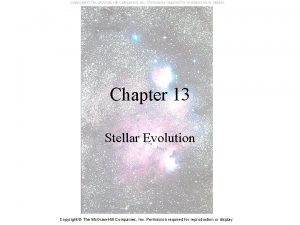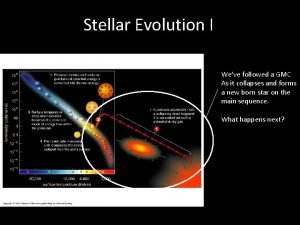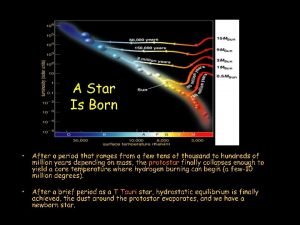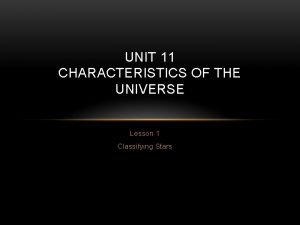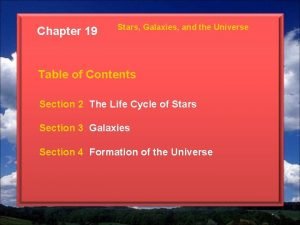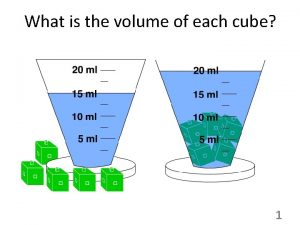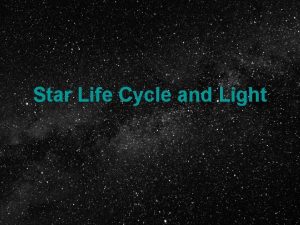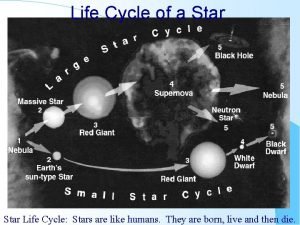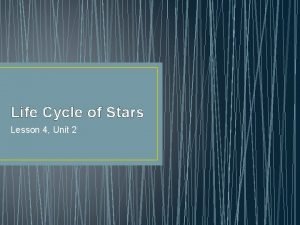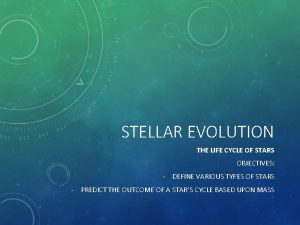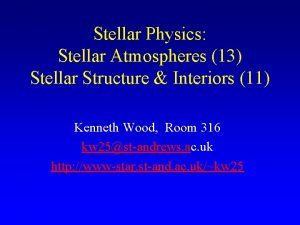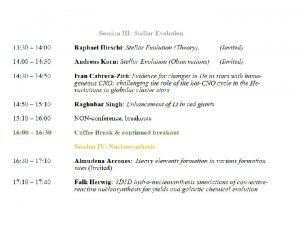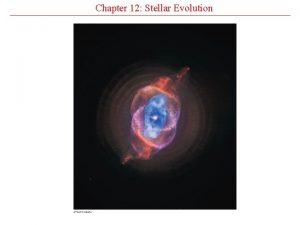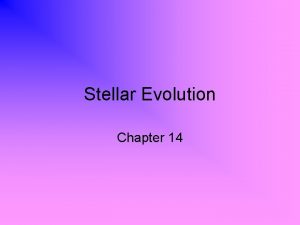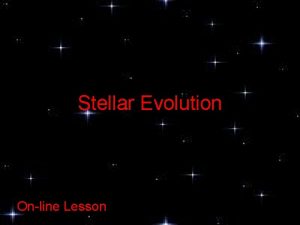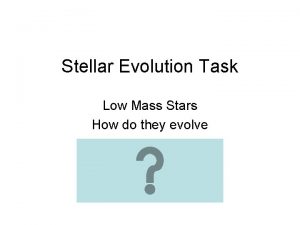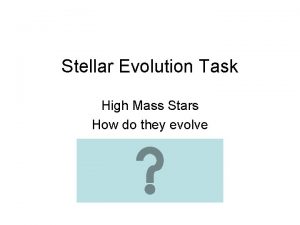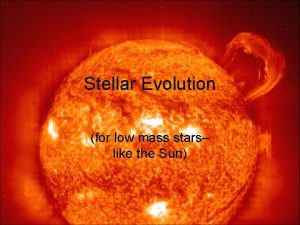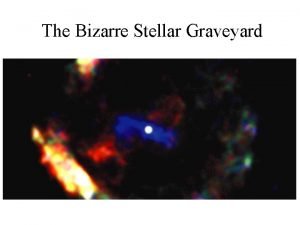Stellar Evolution Life Cycle of stars Stars Mass

















- Slides: 17

Stellar Evolution Life Cycle of stars

Stars ● Mass determines a star’s temperature, luminosity, and diameter. ● Hydrostatic equilibrium is when the inward pressure of gravity is equal to the outward pressure from fusion and radiation. ● If this equilibrium does not exist the star will expand or collapse.

We mentioned the idea of equilibrium within the star-the inward pressure of Gravity and the outward pressure of Fusion. Discuss how these forces would have to act in order to cause: 1) expansion 2) Collapse

Fusion ● Hydrogen molecules fuse together to form helium in the core of a young star. ● Some older, bigger stars can either fuse helium to form other elements or no fusion happens at all.

Star Formation-The beginning of all stars ● All stars form in the same manner. ● The star begins as a cloud of interstellar gas and dust called a nebula. ● The nebula collapses on itself as a result of its own gravity. ● The cloud begins to rotate around the center and when the center gets hot it is called a protostar.

Fusion Begins-A true star is born ● The heat of the protostar increases until it is hot enough to start fusion in the center. ● Once fusion begins it is now stable and a true star. ● This is called the “Main Sequence” stage! Star spends most of it’s life here!

Average size star-Red Giant ● The rest of the life cycle depends on the MASS of the star. ● Only the core of a star is hot enough to fuse hydrogen into helium, when the hydrogen is gone the star begins to expand. ● This expansion turns the star into a red giant.

● When the star is a red giant it begins to lose gas from its outer layers. ● The star gets so large its gravity isn’t strong enough to hold some of the gases together. ● The core however heats up, so hot that helium now can fuse to carbon. ● When the core has used up all of the helium it is now entirely carbon.

Back to nebula ● The stars mass will never get high enough to fuse carbon, so no more energy is produced. ● The outer layers of gas expand are driven off. ● This gas is called a planetary nebula. ● Only the core is left which is a white hot ball of carbon called a white dwarf.

White Dwarfs ● White Dwarfs are about the same size as Earth and are considered dead stars.

Massive Stars ● For stars bigger than the sun a slightly different path is taken. ● They form about the same way, only hydrogen is used up faster, because they are so bright. ● These massive stars become red giants many times, each time it uses up a new layer of gases by fusing different elements together.

Massive Stars ● The star expands to a larger size and becomes a supergiant. ● As the star expands, each time it loses some gases in the outer shell and gets smaller in mass. ● Eventually the star becomes a white dwarf. Instead of being made of only carbon it can be made of many different elements.

Supernovae ● Some stars do not lose enough mass to become a white dwarf. ● These stars are too massive to be stable and meet a violent end. ● Once reactions in the core have made IRON, no more energy is produced and the core collapses in on itself. ● Protons and electrons merge to form neutrons and become a neutron star!

Supernovae ● Neutron stars are incredibly dense, 3 times the mass of our sun but only 10 km in radius! ● The neutron star forms so fast that the gases around the star begin to collapse ● When the gases reach the dense core they explode outward into a supernova. ● Supernovae spread the heavier elements around the universe.

Supermassive Stars (Black Holes) ● Some stars skip the neutron star stage because they are supermassive. ● The gravity is so strong that not even light can escape.

H-R Diagrams ● The properties of mass, luminosity, temperature and diameter are closely related. ● A Hertzsprung –Russell diagram puts all the stars on a graph based on luminosity and surface temperature. ● 90% of all stars fall along a broad strip called the “main sequence” which runs diagonally from top left (hot, bright) to bottom right (cool, dim)

 Flowchart of the life cycle of a star
Flowchart of the life cycle of a star Stellar evolution diagram
Stellar evolution diagram Betelgeuse life cycle
Betelgeuse life cycle Zero age main sequence
Zero age main sequence Stellar evolution
Stellar evolution Stellar evolution
Stellar evolution Stellar evolution
Stellar evolution Stellar evolution
Stellar evolution Life cycle of stars
Life cycle of stars H
H Life cycle of stars graphic organizer
Life cycle of stars graphic organizer Chapter 19 section 2 the life cycle of stars answer key
Chapter 19 section 2 the life cycle of stars answer key Schnauzer dogs there are three sizes
Schnauzer dogs there are three sizes Virginia's 3 major watersheds
Virginia's 3 major watersheds Low mass star life cycle
Low mass star life cycle Life cycle of a star video
Life cycle of a star video Medium mass star life cycle
Medium mass star life cycle Star with small and medium mass
Star with small and medium mass

